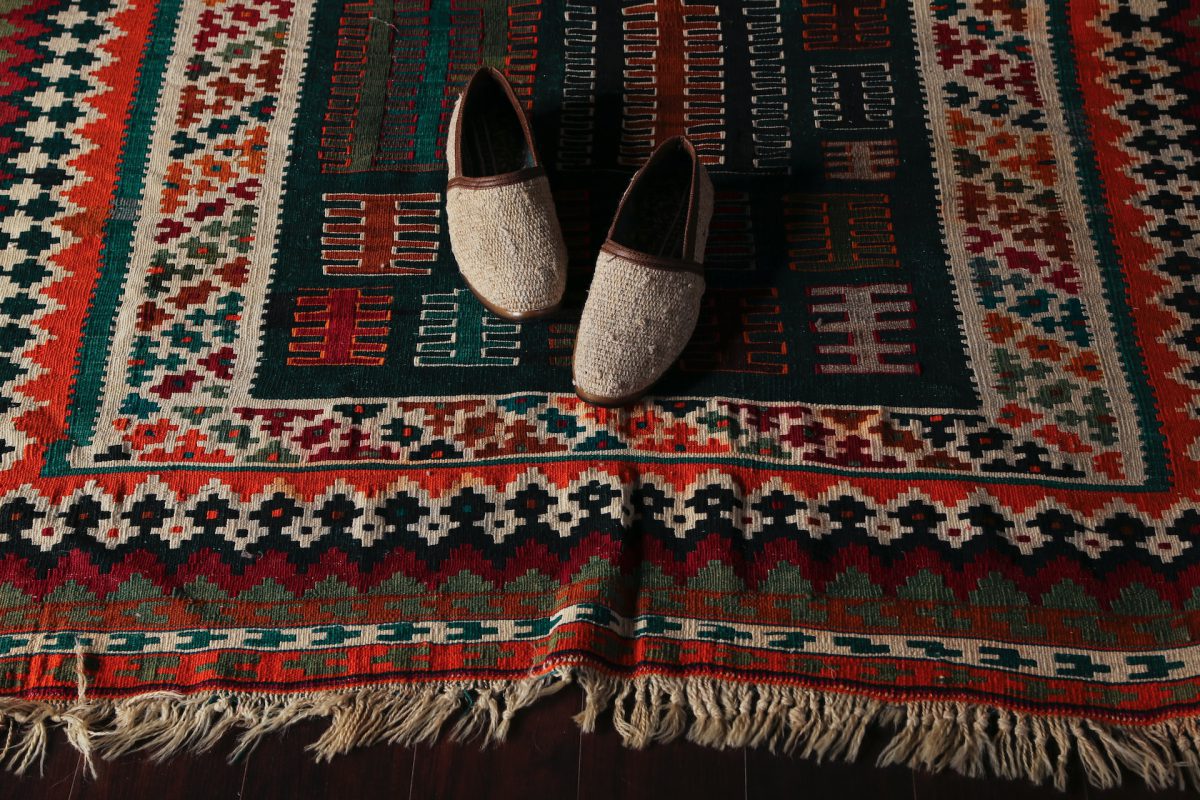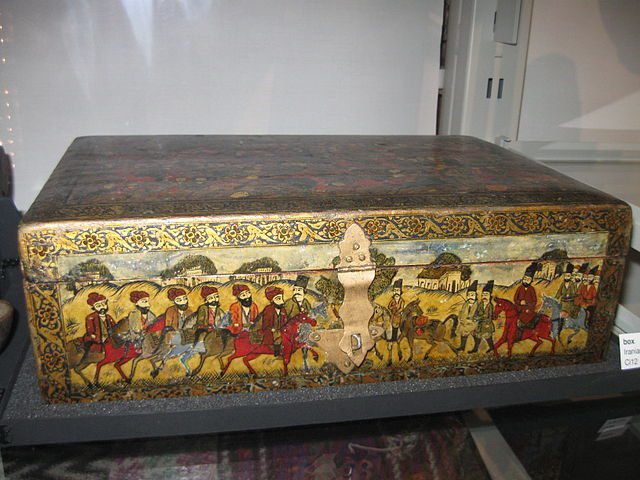Table of Contents
Embark on a journey through the captivating world of Iranian handicrafts, where centuries of artistry have woven a vibrant tapestry of creativity. From intricate pottery to delicate weaving, Iranian artisans have crafted a legacy that stands as a testament to the rich cultural heritage of the region.
Dating back to the Achaemenid Empire around 550 BC, the roots of Iranian handicrafts have flourished through the ages, influenced by neighboring civilizations and evolving into a unique fusion within the broader realm of Islamic art. The hands of skilled craftsmen have shaped remarkable pieces, often mirroring regal figures and animals in a distinctive Persian style.
In exploring Iran and the world of Iranian handicrafts, we uncover a tradition that emphasizes the human form and intricate depictions of animals. What sets it apart is a continued focus on figures, a unique characteristic within Islamic art. Over time, Iranian artisans have perfected a style marked by detailed ornamentation and geometric precision, drawing inspiration from plant motifs and even incorporating elements from Chinese art.
Fast forward to the 16th century, during the Safavid dynasty, and we witness a blossoming of this distinctive style across various crafts, especially in the realm of painting. The impact of court artists becomes evident as their creations leave an enduring mark on the landscape of Iranian handicrafts, showcasing the timeless artistry that continues to captivate admirers worldwide. Here are the top 10 Iranian handicrafts:
Persian Carpet
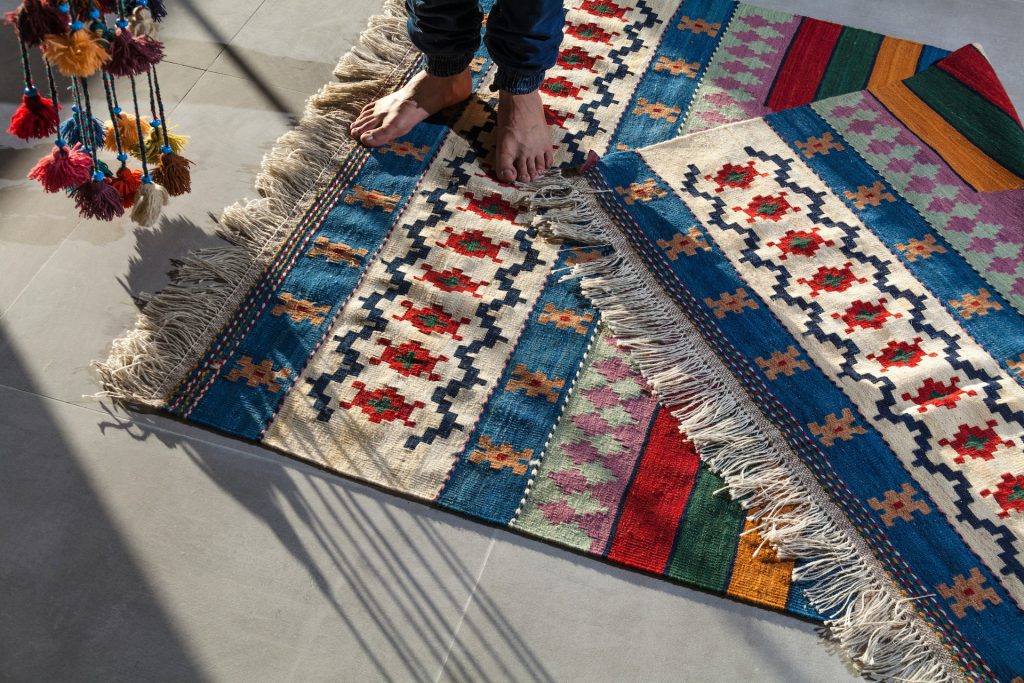
In the world of Iranian crafts, none captivates the West quite like the beautiful art of Persian carpets. These masterpieces gained fame in the 15th century when Europeans first laid eyes on them, showcasing Iran’s unmatched skill in making these special rugs.
The roots of carpet-making in Iran go way back, with the oldest known Iranian carpet, the “Pazyryk,” found around 500 B.C. in Siberia. These carpets, famous for their fancy designs, tell a story of Iran’s long-standing tradition of crafting beautiful rugs.
Making an Iranian carpet is a careful process. Skilled weavers often start by making a detailed paper model, covering a quarter of the carpet before they begin weaving. Nomadic weavers, who move around a lot, bring their creativity to the craft. The carpet itself has a central part and edges, split into three sections, showing off the weavers’ impressive skills.
The real beauty of Iranian carpets lies in their many patterns, telling stories, and using symbols in their designs. Gardens, symbolizing paradise, are a big theme in lots of Persian carpets. There’s a famous carpet that showed a Persian garden in a king’s palace in Ctesiphon, but it changed hands when Muslim Arabs took over in 637.
Nowadays, cities like Isfahan, Qom, Kashan, Kerman, Tabriz, and Yazd, as well as nomadic areas like Bakhtiari and Qashqai, are busy making carpets. The quality of the wool, which is super important for how long the rug lasts and how good it looks, is top-notch in Iran. That’s why Iranian carpets are so special and still popular, letting people own a piece of Iran’s amazing cultural history and Persian handicrafts.
Khatam Kari
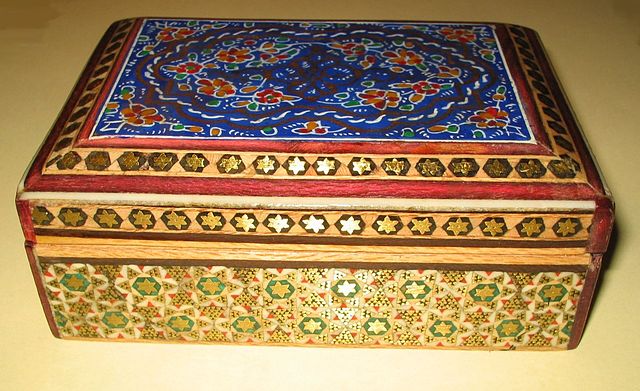
Let’s step into the world of Khatam Kari, one of the best Iranian crafts that puts together small bits of bone, metal, and wood to create something really special. It’s one of Iran’s coolest crafts! For this art, they use thin sticks of wood, camel bone, and brass to make pretty patterns, like stars, on different surfaces.
Here’s how they do it: They take these sticks, make them into triangle shapes, and put them together to make cylinders. These cylinders have cool shapes, like a star inside a hexagon. They make shorter cylinders by cutting the longer ones, then crush and dry them between wooden plates before giving them a nice finish with plating and lacquer. What makes Khatam Kari super impressive is that they manage to fit up to 250 tiny pieces of metal, bone, ivory, and wood into every small space.
This craft isn’t just about making pretty things – it’s like telling a story with every piece. It shows how skilled Iranian craftspeople are and how much they care about keeping their traditions alive. Each Khatam Kari piece is like a little treasure, reminding us of the amazing talent and cultural richness of Iran and Persian handicrafts.
Ghalam Zani
Ghalam Zani is a cool Persian handicraft where artists carefully hammer awesome designs into metals like silver, brass, copper, and gold. This ancient art has been around for a super long time, going back to the Safavid, Sassanid, and Seljuk kingdoms during the Islamic era.
In the last 80 years or so, artists like Mohammad Taghi Zoufan and Mohammad Oraizi brought this old craft back to life. Now, you can find lots of neat stuff with these special engravings in Iranian shops, from candy boxes and plates to candlesticks and trays. Cities like Tehran, Isfahan, and Shiraz are great places to check out these beautifully crafted items, giving you a peek into the timeless art that’s still alive and well in Iran.
Minakari (Enameling)
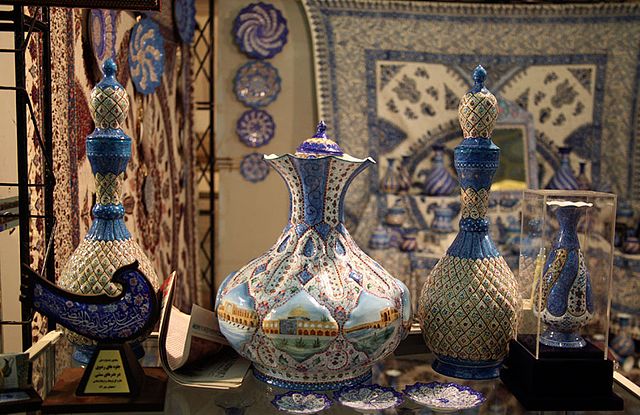
In Persian, Mina means heaven. And Minakari is the art of creating heaven on objects! Since around 1500 B.C., Persians have been creating these elegant artworks by tasteful painting on the surface of glass, ceramic, or metals such as gold, silver, and copper. The oldest Minakari object ever found is a pair of earrings that date back to 800-700 B.C.
It is a fire that fixes the intricate traditional Iranian patterns on the surface. With a gorgeous mixture of colors that feature azure blue and turquoise, these beauties are probably the best souvenirs from Iran. Sometimes, Mina is combined with other Persian handicrafts like Khatam, Miniature, Jewelry, and wooden objects. You can find the finest Minakari vases and plates in Isfahan’s Chahar Bagh Street and Naqsh-e Jahan Square.
Persian Pottery and Ceramic
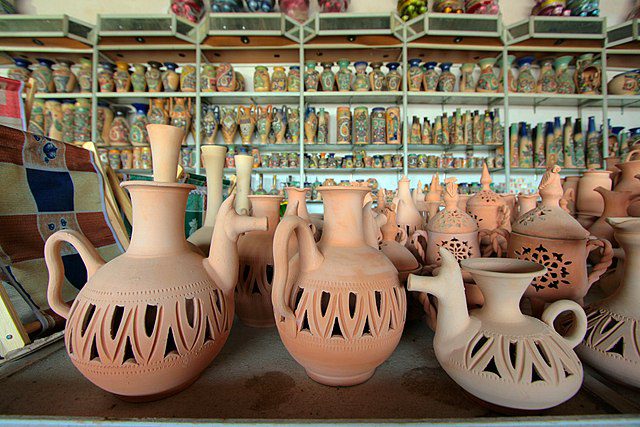
Persian-painted pottery is like a cool window into ancient Persian times, going back to around 7000 B.C. It’s one of the oldest tricks Iranians have been good at for a super long time. As time passed and things changed, Persian pottery and ceramics tried out different looks, using all kinds of patterns, styles, and materials. They got inspiration from nature, old nomadic tribes, Islamic designs, epic stories, and other cultures.
Look at famous places like Golestan Palace, the Pink Mosque, and Naqsh-e Jahan Square – half of their awesomeness comes from these cool tiles. You can find Persian-painted tiles and earthenware in the regular bazaars, but the really special ones are in a place called the Kalporgan Living Museum of Sistan and Baluchestan. This old-school craft not only shows off how good Iranians are at making stuff but also reminds us of their super interesting history and culture.
Firoozeh Koubi
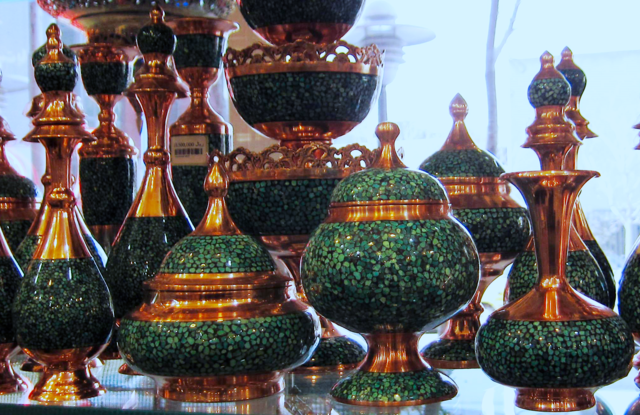
Firoozeh Koubi is one of the Iranian crafts that people like. It’s all about carefully putting small bits of turquoise on metals like copper, brass, silver, and gold in a cool pattern. This makes the items shine and look different from others.
These tiny turquoise pieces aren’t just for plates and utensils; they also go on pretty accessories like earrings, rings, and necklaces. If you’re in Iran, you can get these special plates with turquoise at a good price, and tourists really like them. Turquoise is a pretty blue stone that people have liked for a really long time. Even though Firoozeh Koubi is kinda new, only around 70 years old, it’s doing great, especially in Isfahan, making Iranian crafts look even cooler.
Iranian Miniature
A Persian miniature is a little piece of art, whether it’s a tiny painting on paper, an illustration in a book, or something made from materials like camel bone. All these pieces come together in a collection known as a “Murraqa.”
The techniques used in Persian miniatures have their roots in Western and Byzantine traditions of small, decorated manuscripts. In Iran, this tradition goes beyond just paintings and includes things like jewelry boxes with tiny paintings on them. Persian wall painting has been around for a long time, but miniatures, being smaller, have been preserved better and are now the most well-known type of Persian painting in the Western world. You can find many great examples in Western and Turkish museums.
Back in the 13th century, when the Mongols invaded, they brought new influences from China, giving a boost to miniature painting. By the 13th century, it had become a big deal in Persian art, reaching its peak in the 15th and 16th centuries. The tradition stuck around, picking up some Western ideas along the way, and today, a few artists still keep it going.
Termeh Weaving
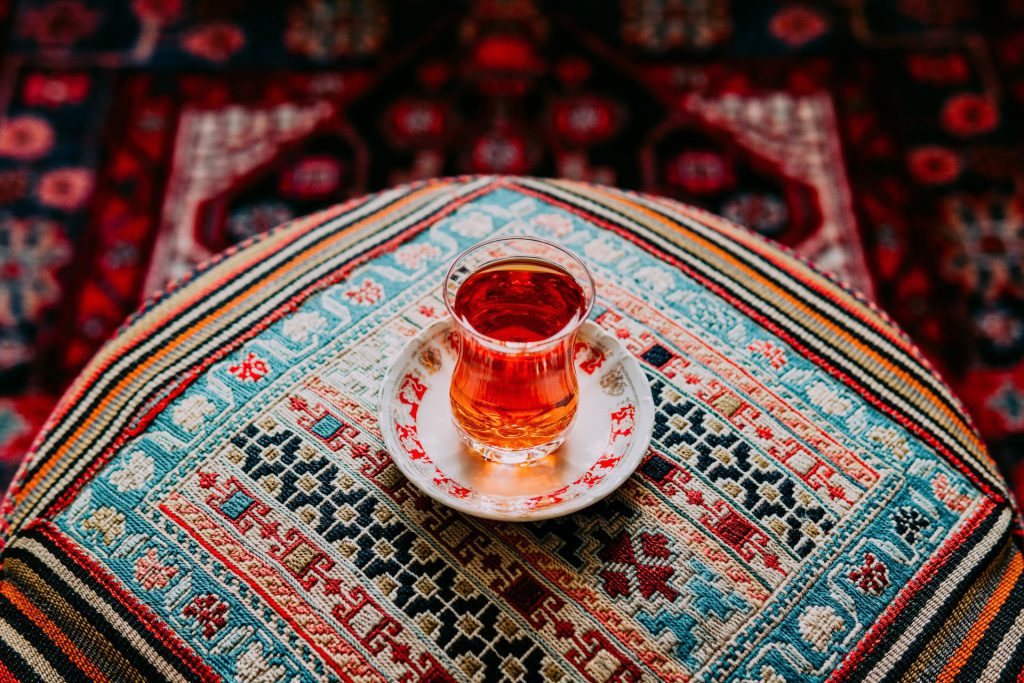
Termeh is a special Persian handicraft that comes from Yazd. It’s a lively fabric with fancy designs, especially the cool paisley pattern. They make this fabric using really good threads, mixing things like silk, fluff, and wool to make it soft and look nice.
A long time ago, before there were lots of clothes everywhere, Termeh was super popular, especially with rich people. Making Termeh is a careful and slow process, and it’s been a favorite skill in Iran since a really long time ago, back in the Safavid period.
Baluchi Soozan Doozi (Embroidery)
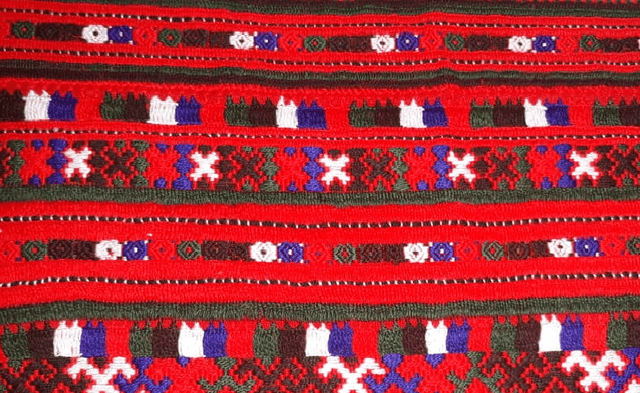
In the dusty desert and mountains of Southeast Iran, the Baloch people bring color and life to their surroundings with their special art: Soozan Doozi. It’s a kind of embroidery or needlework that you can find on Baluch clothes and jewelry. Women stitch pretty patterns on their trousers, dresses, and shawls, while men have hand-embroidered designs on their caps.
If you want to see the best of Baluchi embroidery and get to know the friendly Baluch people, you should check out the towns and villages in Sistan and Baluchestan. There, you’ll see the beautiful patterns that tell the story of the Baloch culture and how creative they are with their Soozan Doozi art.
Giveh Weaving
Giveh, a light and comfy shoe, is handwoven by Iranian crafters using a cool material, usually carpet yarn. This old-school Iranian craft comes from far-off places and has been something families do at home for a long time. Not too far back, everyone in Iran liked wearing these shoes.
What’s neat about Giveh is that the material has tiny holes, so they’re great for hot days. People in different towns like Shiraz, Zanjan, and Kermanshah make them in lots of colors.
FAQS about Iranian Handicrafts
Q1: What is the famous handicraft of Iran?
A1: Some well-known crafts from Iran are the Persian Carpet, Minakari (silver carvings), miniature art, Khatamkari, and Ghalamzani (Metalwork). Iran has a rich history of various traditional crafts.
Q2: What types of handicrafts did Persians create?
A2: Iran has many traditional crafts that show off their unique skills and culture. These include making baskets, carpets, textiles, metal items, wooden objects, pottery, stone and mosaic work, and creating paintings and drawings. These crafts have been passed down through generations and highlight Iran’s long-standing artistic traditions.
Q3: What are the traditional arts in Iran?
A3: Persian or Iranian art holds a prominent place in world history with one of the most abundant art legacies. It has excelled in various forms of expression such as architecture, painting, weaving, pottery, calligraphy, metalworking, and sculpture.
Q4: What is the meaning of Khatamkari?
A4: In the Persian encyclopedia, Khatam Kari, or inlay work, is defined as the art of adorning object surfaces in a mosaic style using small triangles.
Q5: What is the meaning of Ghalamzani?
A5: Engraving, known as Ghalam Zani, is the art of crafting intricate designs on different metals like copper, brass, silver, and gold. Isfahan serves as the primary hub for this craft. The beautiful creations by artists in this field stand as a magnificent and undeniable representation of Iran’s historical metalwork, especially in Isfahan.
Last Words: Explore the Best of Iranian Handicrafts with a Customized Tour
Iranian handicrafts, rooted in a centuries-old tradition, showcase the exquisite skills of artisans in pottery, weaving, and metalwork. With influences from ancient civilizations and a distinctive Persian style, these crafts feature intricate designs inspired by nature and historical elements. The Safavid dynasty in the 16th century marked a pinnacle, especially in painting, leaving an enduring impact. Today, Iranian handicrafts stand as cultural treasures, reflecting the country’s rich heritage through functional and artistic creations.
To truly immerse yourself in the enchanting world of Iranian craftsmanship, consider opting for Customized tours that cater specifically to your preferences. In that case, let To Iran Tour be your guide in unraveling the beauty of Iranian Handicrafts through our meticulously crafted customized tours. We are not just offering trips; we are here to help you create lasting memories and have a truly great experience in Iran.

